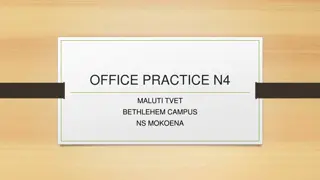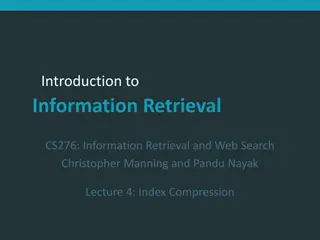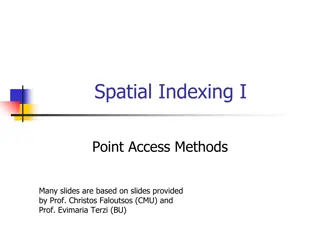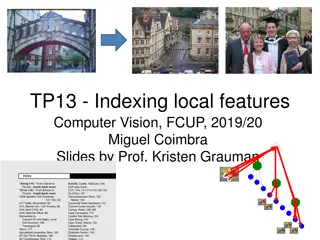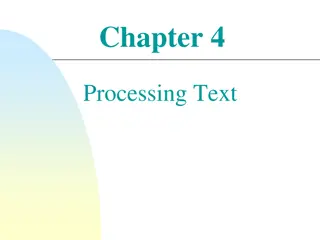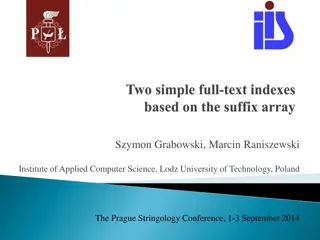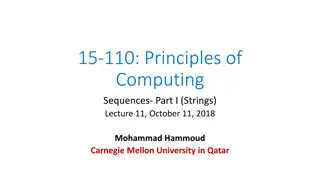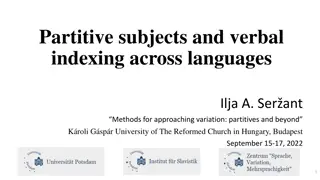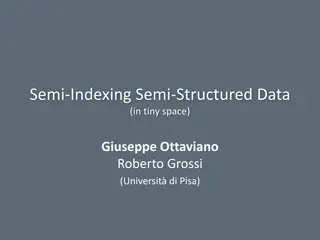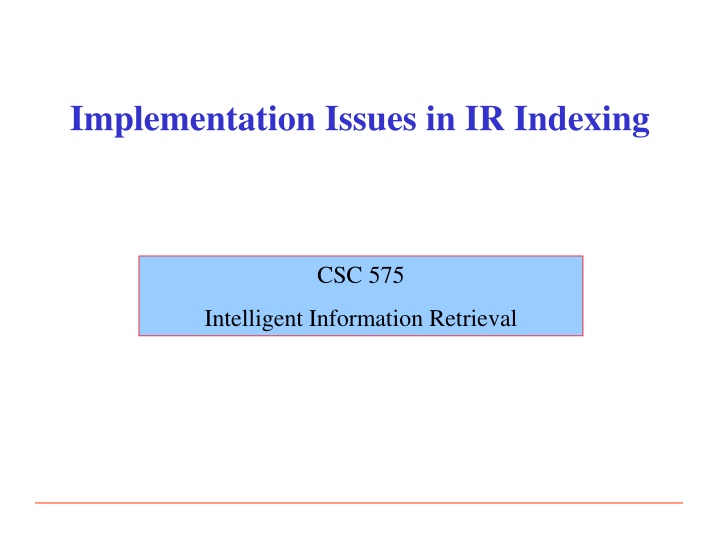
Intelligent Information Retrieval: Indexing Implementation Issues
Learn about the implementation issues in intelligent information retrieval (CSC 575) including lexical analysis, stop words, indexing, and the Vector Space Model. Explore how documents and queries are represented as vectors in n-dimensional space for efficient retrieval. Understand the construction of indexes, query processing, and the importance of the Vector Space Model in information retrieval.
Download Presentation

Please find below an Image/Link to download the presentation.
The content on the website is provided AS IS for your information and personal use only. It may not be sold, licensed, or shared on other websites without obtaining consent from the author. If you encounter any issues during the download, it is possible that the publisher has removed the file from their server.
You are allowed to download the files provided on this website for personal or commercial use, subject to the condition that they are used lawfully. All files are the property of their respective owners.
The content on the website is provided AS IS for your information and personal use only. It may not be sold, licensed, or shared on other websites without obtaining consent from the author.
E N D
Presentation Transcript
Implementation Issues in IR Indexing CSC 575 Intelligent Information Retrieval
Lexical analysis and stop words Information need Collections Pre-process text input Parse Index Query How is the index constructed? Rank Result Sets
Indexing Implementation Inverted Indexes Primary data structure for text indexes Source file: collection, organized by document Inverted Index: collection organized by term (one record per term, listing locations where term occurs) Query: traverse lists for each query term OR: the union of component lists AND: an intersection of component lists Based on the view of documents as vectors in n-dimensional space n = number of index terms used for indexing Each document is a bag of words (vector) with a direction and a magnitude The Vector-Space Model for IR Intelligent Information Retrieval 3
The Vector Space Model Vocabulary V = the set of terms left after pre-processing the text (tokenization, stop-word removal, stemming, ...). Each document or query is represented as a |V| = n dimensional vector: dj = [w1j, w2j, ..., wnj]. wij is the weight of term i in document j. the terms in V form the orthogonal dimensions of a vector space Document = Bag of words: Vector representation doesn t consider the ordering of words: John is quicker than Mary vs. Mary is quicker than John. 4
Document Vectors and Indexes Conceptually, the index can be viewed as a document- term matrix Each document is represented as an n-dimensional vector (n = no. of terms in the dictionary) Term weights represent the scalar value of each dimension in a document The inverted file structureis an implementation model used in practice to store the information captured in this conceptual representation The dictionary Document Ids nova galaxy heat hollywood film role diet fur A 1.0 0.5 0.3 B 0.5 1.0 C 1.0 0.8 0.7 D 0.9 1.0 0.5 E 1.0 1.0 F G 0.5 0.7 H 0.6 1.0 0.3 0.2 0.8 I 0.7 0.5 0.1 0.3 Term Weights (in this case normalized) a document vector 0.9 1.0 0.9 Intelligent Information Retrieval 5
Example: Documents and Query in 3D Space Documents in term space Terms are usually stems Documents (and the query) are represented as vectors of terms Query and Document weights based on length and direction of their vector Why use this representation? A vector distance measure between the query and documents can be used to rank retrieved documents Intelligent Information Retrieval 6
How Are Inverted Files Created Term now is the time for all good men to come to the aid of their country it was a dark and stormy night in the country manor the time was past midnight Doc # 1 1 1 1 1 1 1 1 1 1 1 1 1 1 1 1 2 2 2 2 2 2 2 2 2 2 2 2 2 2 2 2 Sorted Array Implementation Documents are parsed to extract tokens. These are saved with the Document ID. Doc 1 Doc 2 It was a dark and stormy night in the country manor. The time was past midnight Now is the time for all good men to come to the aid of their country Intelligent Information Retrieval 7
How Inverted Files are Created Term now is the time for all good men to come to the aid of their country it was a dark and stormy night in the country manor the time was past midnight Doc # Term a aid all and come country country dark for good in is it manor men midnight night now of past stormy the the the the their time time to to was was Doc # 1 1 1 1 1 1 1 1 1 1 1 1 1 1 1 1 2 2 2 2 2 2 2 2 2 2 2 2 2 2 2 2 2 1 1 2 1 1 2 2 1 1 2 1 2 2 1 2 2 1 1 2 2 1 1 2 2 1 1 2 1 1 2 2 After all documents have been parsed and the inverted file is sorted (with duplicates retained for within document frequency stats) If frequency information is not needed, then inverted file can be sorted with duplicates removed. Intelligent Information Retrieval 8
How Inverted Files are Created Term a aid all and come country country dark for good in is it manor men midnight night now of past stormy the the the the their time time to to was was Doc # 2 1 1 2 1 1 2 2 1 1 2 1 2 2 1 2 2 1 1 2 2 1 1 2 2 1 1 2 1 1 2 2 Term a aid all and come country country dark for good in is it manor men midnight night now of past stormy the the their time time to was Doc # Freq Multiple term entries for a single document are merged Within-document term frequency information is compiled If proximity operators are needed, then the location of each occurrence of the term must also be stored. Terms are usually represented by unique integers to fix and minimize storage space. 2 1 1 2 1 1 2 2 1 1 2 1 2 2 1 2 2 1 1 2 2 1 2 1 1 2 1 2 1 1 1 1 1 1 1 1 1 1 1 1 1 1 1 1 1 1 1 1 1 2 2 1 1 1 2 2 Intelligent Information Retrieval 9
How Inverted Files are Created Then the file can be split into a Dictionary and a Postings file Doc # Freq Term a aid all and come country dark for good in is it manor men midnight night now of past stormy the their time to was N docs (DF) 1 1 1 1 1 2 1 1 1 1 1 1 1 1 1 1 1 1 1 1 2 1 2 1 1 Tot Freq Doc # Freq 2 1 1 2 1 1 2 1 1 2 1 2 2 1 2 2 1 1 2 2 1 1 1 1 2 1 1 1 1 1 1 1 1 1 1 1 1 1 1 1 1 1 1 1 1 2 1 1 2 2 1 1 1 1 1 2 1 1 1 1 1 1 1 1 1 1 1 1 1 1 4 1 2 2 2 2 1 2 2 2 1 Dictionary Postings Intelligent Information Retrieval 10
Inverted Indexes and Queries Permit fast search for individual terms For each term, you get a hit list consisting of: document ID frequency of term in doc position of term in doc (optional) These lists can be used to solve quickly Boolean queries: country ==> {d1, d2} manor ==> {d2} country AND manor ==> {d2} Full advantage of this structure can taken by statistical ranking algorithms such as the vector space model in case of Boolean queries, term or document frequency information is not used (just set operations performed on hit lists) Intelligent Information Retrieval 11
Scalability Issues: Number of Postings An Example: Reuters RCV1 Collection Number of docs = m = 800,000 Average tokens per doc: 200 Number of distinct terms = n = 400K 100 million (non-positional) postings in the inverted index Intelligent Information Retrieval 12
Bottleneck Parse and build postings entries one doc at a time Sort postings entries by term (then by doc within each term) Doing this with random disk seeks would be too slow must sort N=100M records If every comparison took 2 disk seeks (10 milliseconds each), and N items could be sorted with N log2N comparisons, how long would this take? Intelligent Information Retrieval 13
Sorting with fewer disk seeks 12-byte (4+4+4) records (term, doc, freq) These are generated as we parse docs Must now sort these 12-byte records by term Define a Block (e.g., ~ 10M) records Blocks defined such that each block can fit in memory Sort within blocks first (in memory) and write to disk, then merge the blocks into one long sorted order. Blocked Sort-Based Indexing (BSBI) Intelligent Information Retrieval 14
Blocked Sort-Based Indexing - Example BSBI Example with two blocks: The two blocks ( postings lists to be merged ) are loaded from disk into memory, merged in memory ( merged postings lists ) and written back to disk. Terms are shown instead of termIDs for better readability. Intelligent Information Retrieval 15
Sec. 4.3 Problem with Sort-Based Algorithm Assumption: we can keep the dictionary in memory. We need the dictionary (which grows dynamically) in order to implement a term to termID mapping. Actually, we could work with term, docID postings instead of termID, docID postings . . . . . . but then intermediate files become very large. (We would end up with a scalable, but very slow index construction method.)
Sec. 4.3 SPIMI: Single-pass in-memory indexing Key idea 1: Generate separate dictionaries for each block no need to maintain term-termID mapping across blocks. Key idea 2: Don t sort. Accumulate postings in postings lists as they occur. With these two ideas we can generate a complete inverted index for each block. These separate indexes can then be merged into one big index.
Sec. 4.3 SPIMI-Invert Sec. 4.3, IR Book Merging of blocks is analogous to BSBI.
Distributed indexing For web-scale indexing must use a distributed computing cluster Individual machines are fault-prone Can unpredictably slow down or fail How do we exploit such a pool of machines? Maintain a master machine directing the indexing job considered safe . Break up indexing into sets of (parallel) tasks. Master machine assigns each task to an idle machine from a pool. Intelligent Information Retrieval 19
Parallel tasks Use two sets of parallel tasks Parsers Inverters Break the input document corpus into splits Each split is a subset of documents E.g., corresponding to blocks in BSBI Master assigns a split to an idle parser machine Parser reads a document at a time and emits (term, doc) pairs writes pairs into j partitions Each partition is for a range of terms first letters (e.g., a-f, g-p, q-z) here j = 3. Inverter collects all (term, doc) pairs for a partition; sorts and writes to postings list Intelligent Information Retrieval 20
Sec. 4.4 Data flow Master assign assign Postings a-f a-f g-p q-z Parser Inverter a-f g-p q-z Parser Inverter g-p splits Inverter q-z a-f g-p q-z Parser Map phase Reduce phase Segment files Intelligent Information Retrieval 21
Example for index construction Caesar Map: d1 : C came, C c ed. d2 : C died. <C,d1>, <came,d1>, <C,d1>, <c ed, d1>, <C, d2>, <died,d2> conquered Reduce: (<C,(d1,d1,d2)>, <died,(d2)>, <came,(d1)>, <c ed,(d1)>) (<C,(d1:2,d2:1)><died,(d2:1)>, <came,(d1:1)>,<c ed,(d1:1)>) 22
Dynamic indexing Problem: Docs come in over time postings updates for terms already in dictionary new terms added to dictionary Docs get deleted Simplest Approach Maintain a big main index New docs go into a small auxiliary index Search across both, merge results Deletions Invalidation bit-vector for deleted docs Filter docs output on a search result by this invalidation bit-vector Periodically, re-index into one main index Intelligent Information Retrieval 23
Index on disk vs. memory Most retrieval systems keep the dictionary in memory and the postings on disk Web search engines frequently keep both in memory massive memory requirement feasible for large web service installations less so for commercial usage where query loads are lighter Intelligent Information Retrieval 24
Retrieval From Indexes Given the large indexes in IR applications, searching for keys in the dictionaries becomes a dominant cost Two main choices for dictionary data structures: Hashtables or Trees Using Hashing requires the derivation of a hash function mapping terms to locations may require collision detection and resolution for non-unique hash values Using Trees Binary search trees nice properties, easy to implement, and effective enhancements such as B+ trees can improve search effectiveness but, requires the storage of keys in each internal node Intelligent Information Retrieval 25
Sec. 3.1 Hashtables Each vocabulary term is hashed to an integer (We assume you ve seen hashtables before) Pros: Lookup is faster than for a tree: O(1) Cons: No easy way to find minor variants: judgment/judgement No prefix search If vocabulary keeps growing, need to occasionally do the expensive operation of rehashing everything 26
Sec. 3.1 Trees Simplest: binary tree More usual: B-trees Trees require a standard ordering of characters and hence strings but we typically have one Pros: Solves the prefix problem (e.g., terms starting with hyp) Cons: Slower: O(log M) [and this requires balanced tree] Rebalancing binary trees is expensive But B-trees mitigate the rebalancing problem 27
Sec. 3.1 Tree: binary tree Root a-m n-z a-hu hy-m n-sh si-z 28
Sec. 3.1 Tree: B-tree n-z a-hu hy-m Definition: Every internal node has a number of children in the interval [a,b] where a, b are appropriate natural numbers, e.g., [2,4]. 29
Indexing Implementation We will discuss some specific algorithms and constructs for implementing and searching Vector Space Inverted indexes later But, First, we ll look more closely at indexing models which refer to different models for associating weights to terms in the index Intelligent Information Retrieval 30



